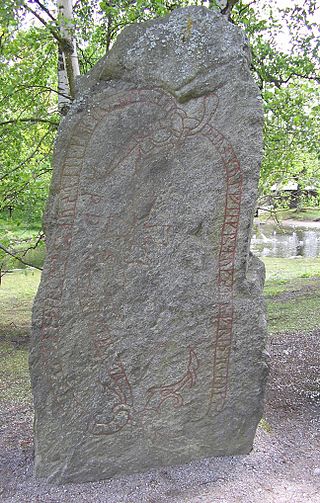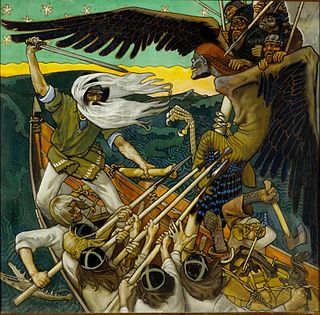Related Research Articles

Finnicization is the changing of one's personal names from other languages into Finnish. During the era of National Romanticism in Finland, many people, especially Fennomans, finnicized their previously Swedish family names.
Kvenland, known as Cwenland, Qwenland, Kænland, and similar terms in medieval sources, is an ancient name for an area in Fennoscandia and Scandinavia. Kvenland, in that or nearly that spelling, is known from an Old English account written in the 9th century, which used information provided by Norwegian adventurer and traveler Ohthere, and from Nordic sources, primarily Icelandic. A possible additional source was written in the modern-day area of Norway. All known Nordic sources date from the 12th and 13th centuries. Other possible references to Kvenland by other names and spellings are also discussed here.
A few Icelandic sagas tell about kings that ruled in Kvenland.
The origin of the name Kven is unclear. The name appears for the first time in a 9th-century Old English version, written by King Alfred of Wessex, of a work by the Roman author Orosius, in the plural form Cwenas.

There are scattered descriptions of early Finnish wars, conflicts involving the Finnish tribes, some of which took place before the Middle Ages. The earliest historical accounts of conflicts involving Finnish tribes, such as Tavastians, Karelians, Finns proper and Kvens, have survived in Icelandic sagas and in German, Norwegian, Danish and Russian chronicles as well as in Swedish legends and in Birch bark manuscripts. The most important sources are Novgorod First Chronicle, Primary Chronicle and Eric Chronicles.
The origin of the name Kainuu has been disputed among Finnish historians and linguistics. Kainuu is a region of Finland. The reason for the controversy is the speculated connection between areas known as Kainuu and Kvenland, both historical lands in Fennoscandia.

Mauno Jokipii was a Finnish professor at the University of Jyväskylä in history specializing in World War II. He was a thorough investigator and a prolific author. Among his works were studies of the local history of Jyväskylä and the university and historical province of Satakunta.
Thorolf Kveldulfsson was the oldest son of Kveldulf Bjalfasson and brother of the Norwegian/Icelandic goði and skald Skalla-Grimr. His ancestor Hallbjorn was nicknamed "halftroll", possibly indicating Norwegian-Sami ancestry.

Sastamala is a town and municipality of Finland. It is located in the Pirkanmaa region. The town has a population of 23,618 and covers an area of 1,531.75 square kilometres (591.41 sq mi) of which 96.14 km2 (37.12 sq mi) is water, making it the largest municipality in the Pirkanmaa region in terms of area. The population density is 18.29 inhabitants per square kilometre (47.4/sq mi). The municipality is unilingually Finnish.

Jalmari Verneri Sauli was a Finnish writer and track and field athlete who competed in the 1908 Summer Olympics.

Finnish is a Uralic language of the Finnic branch, spoken by the majority of the population in Finland and by ethnic Finns outside of Finland. Finnish is one of the two official languages of Finland. In Sweden, both Finnish and Meänkieli are official minority languages. The Kven language, which like Meänkieli is mutually intelligible with Finnish, is spoken in the Norwegian county Troms og Finnmark by a minority group of Finnish descent.

The Kylfings were a people of uncertain origin active in Northern Europe during the Viking Age, roughly from the late ninth century to the early twelfth century. They could be found in areas of Lapland, Russia, and the Byzantine Empire that were frequented by Scandinavian traders, raiders and mercenaries. Scholars differ on whether the Kylfings were ethnically Finnic or Norse. Also disputed is their geographic origin, with Denmark, Sweden and the Eastern Baltic all put forward as candidates. Whether the name Kylfing denotes a particular tribal, socio-political, or economic grouping is also a matter of much debate.

Kanteletar is a collection of Finnish folk poetry compiled by Elias Lönnrot. It is considered to be a sister collection to the Finnish national epic Kalevala. The poems of Kanteletar are based on the trochaic tetrameter, generally referred to as "Kalevala metre".

St. Olaf's Church, also known as Ulvila Church, is a church of the Evangelical Lutheran Church of Finland in Ulvila, Finland. The church is considered one of the best-preserved medieval fieldstone churches in Finland and is the only remaining structure from the medieval town of Ulvila. St. Olaf has been the patron saint of the church since before 1429.
Anna-Liisa Hirviluoto was a Finnish archaeologist. She made her career in the Finnish National Board of Antiquities and its predecessor, the Archaeological Commission positions for 35 years.

Synty is an important concept in Finnish mythology. Syntysanat ('origin-words') or syntyloitsut ('origin-charms') provide an explanatory, mythical account of the origin of a phenomenon, material, or species, and were an important part of traditional Finno-Karelian culture, particularly in healing rituals. Although much in the Finnish traditional charms is paralleled elsewhere, 'the role of aetiological and cosmogonic myths' in Finnic tradition 'appears exceptional in Eurasia'. The major study remains that by Kaarle Krohn, published in 1917.

The Golden Age of Finnish Art coincided with the national awakening of Finland, during the era of the Grand Duchy of Finland under the Russian Empire. It is believed to span an era from the late 19th Century to the early 20th Century, approximately 1880 to 1910. The epic poetry form known as Kalevala, developed during the 19th Century, provided the artistic inspiration for numerous themes at the time, including in visual arts, literature, music and architecture; however, the "Golden Age of Finnish Art" is generally regarded as referring to the realist and romantic nationalist painters of the time. Notable figures of the time include Akseli Gallen-Kallela, Pekka Halonen, Albert Edelfelt, Jean Sibelius, Eino Leino, Helene Schjerfbeck, Emil Wikström, Eero Järnefelt and Eliel Saarinen.

Väinö David Lassila was a Finnish physician, anatomist and anthropologist who was a Professor of Anatomy at the University of Helsinki. He was the leading authority of the Finnish racial studies, but since the mid-1930s, Lassila dissociated himself from racial theories and became one of the prominent figures of Finland's human rights movement.

Ancient kings of Finland are kings of Finland mentioned in early historical sources. The word kuningas is an old Finnic word deriving from the ancient Germanic word kuningaz. In the time the sources were written, "Finland" mainly referred to the Finland Proper area, and depending on the source, the "kings of Finland" could also refer to kings of the Sami people.

Martti Aleksander Pihkala was a National Coalition Party MP who became known as a Jäger activist, Ostrobothnia White Guard founder, in the 1920s and 1930s, leader of the strikebreaking organisation Export Peace, also known as "Pihkala's Guard" and an influencer of the Lapua movement and the Patriotic People's Movement.
References
- ↑ Mikko Häme, Egilin saagan lapinkuvauksen ajoituksesta, in Faravid Pohjois-Suomen historiallisen yhdistyksen vuosikirja, 3/79, p. 79
- ↑ Unto Salo, Ajan ammoisen oloista, Satakunnan ja naapurimaakuntien esihistoriaa, Suomen Kirjallisuuden Seura 2008, p. 263
- ↑ Unto Salo, Faravidin retket ja Satakunnan organisoituminen, in Faravid Pohjois-Suomen historiallisen yhdistyksen vuosikirja, 27/2003, p. 35
- ↑ "Egil's Saga - Icelandic Saga Database". Icelandic Saga Database.
- ↑ Leppäaho
- ↑ Unto Salo, Faravidin retket ja Satakunnan organisoituminen, in Faravid Pohjois-Suomen historiallisen yhdistyksen vuosikirja, 27/2003, p. 34
- ↑ Unto Salo, Ajan ammoisen oloista, Satakunnan ja naapurimaakuntien esihistoriaa, Suomen Kirjallisuuden Seura 2008, p. 273
- ↑ Unto Salo, Ajan ammoisen oloista, Satakunnan ja naapurimaakuntien esihistoriaa, Suomen Kirjallisuuden Seura 2008, p. 276
- ↑ Unto Salo, Faravidin retket ja Satakunnan organisoituminen, in Faravid Pohjois-Suomen historiallisen yhdistyksen vuosikirja, 27/2003, p. 47
- ↑ Unto Salo, Faravidin retket ja Satakunnan organisoituminen, in Faravid Pohjois-Suomen historiallisen yhdistyksen vuosikirja, 27/2003, p. 51
- ↑ Unto Salo, Ajan ammoisen oloista, Satakunnan ja naapurimaakuntien esihistoriaa, Suomen Kirjallisuuden Seura 2008, p. 279
- ↑ Unto Salo, Ajan ammoisen oloista, Satakunnan ja naapurimaakuntien esihistoriaa, Suomen Kirjallisuuden Seura 2008, p. 282
- ↑ Unto Salo, Faravidin retket ja Satakunnan organisoituminen, in Faravid Pohjois-Suomen historiallisen yhdistyksen vuosikirja, 27/2003, p. 52
- ↑ Pirkko-Liisa Lehtosalo-Hilander, Kalastajista Kauppanaisiin (Euran esihistoria, Rauma 2000), p. 277